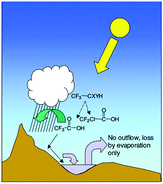Increased UV-B through stratospheric ozone depletion leads to an increased chemical activity in the lower atmosphere (the troposphere). The effect of stratospheric ozone depletion on tropospheric ozone is small (though significant) compared to the ozone generated anthropogenically in areas already experiencing air pollution. Modeling and experimental studies suggest that the impacts of stratospheric ozone depletion on tropospheric ozone are different at different altitudes and for different chemical regimes. As a result the increase in ozone due to stratospheric ozone depletion may be greater in polluted regions. Attributable effects on concentrations are expected only in regions where local emissions make minor contributions. The vertical distribution of NOX
(NO + NO2), the emission of volatile organic compounds and the abundance of water vapor, are important influencing factors. The long-term nature of stratospheric ozone depletion means that even a small increase in tropospheric ozone concentration can have a significant impact on human health and the environment.
Trifluoroacetic acid (TFA) and chlorodifluoroacetic acid (CDFA) are produced by the atmospheric degradation of hydrochlorofluorocarbons (HCFCs) and hydrofluorocarbons (HFCs). TFA has been measured in rain, rivers, lakes, and oceans, the ultimate sink for these and related compounds. Significant anthropogenic sources of TFA other than degradation HCFCs and HFCs have been identified. Toxicity tests under field conditions indicate that the concentrations of TFA and CDFA currently produced by the atmospheric degradation of HFCs and HCFCs do not present a risk to human health and the environment.
The impact of the interaction between ozone depletion and future climate change is complex and a significant area of current research. For air quality and tropospheric composition, a range of physical parameters such as temperature, cloudiness and atmospheric transport will modify the impact of UV-B. Changes in the chemical composition of the atmosphere including aerosols will also have an impact. For example, tropospheric OH is the ‘cleaning’ agent of the troposphere. While increased UV-B increases the OH concentration, increases in concentration of gases like methane, carbon monoxide and volatile organic compounds will act as sinks for OH in troposphere and hence change air quality and chemical composition in the troposphere. Also, changes in the aerosol content of the atmosphere resulting from global climate change may affect ozone photolysis rate coefficients and hence reduce or increase tropospheric ozone concentrations.


 Please wait while we load your content...
Please wait while we load your content...